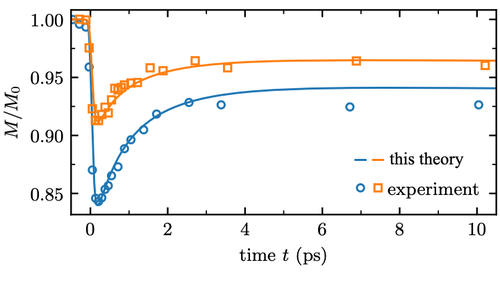Ultrafast demagnetization through rapid spin-wave generation - TRR 227 publication in Adv. Physics Res.
Fig. 1: Magnon dispersion of iron shown for wave vectors in reciprocal space.
Fig. 2: Comparison between theory and experiment for the ultrafast loss of magnetization M of an iron film upon laser excitation at t = 0.
Excitation of a ferromagnetic material with a femtosecond laser pulse causes an ultrafast magnetization drop, but the deeper mechanism behind this ultrafast drop has been disputed for many years. Physicists within the CRC/TRR 227 now show that ultrafast generation of non-thermal spin waves can explain a rapid magnetization loss within 200 femtoseconds (fs) consistent with experiments.
News from Feb 12, 2024
More than 25 years ago, it was discovered by Beaurepaire and collaborators that a laser pulse as short as some 50 fs could alter the magnetization of a ferromagnetic material in less than 200 fs. For a multilayer system consisting of ferromagnetic and non-magnetic metallic layers, the magnetization of a ferromagnetic layer can be quickly reduced due to a superdiffusive spin current going from the ferromagnet to the non-magnetic metal. But for an isolated ferromagnetic film it has been a long-standing mystery through what mechanism the ultrafast magnetization loss could be explained. Several proposals were previously made, based on the ideas that laser excitation of a ferromagnetic metal could lead to a transfer of spin moment from the electrons to other constituents of the material, namely, the lattice vibrations and spin waves.
To tackle this problem, physicists Markus Weißenhofer (FU Berlin) and Peter Oppeneer (Uppsala University, MF) developed a fully out-of-equilibrium theory to describe the transfer of energy and spin angular momentum between electrons and quantized spin waves, called magnons. In their theory the laser pulse dumps energy into the electrons that react by transferring their excess energy as well as spin angular momentum into spin waves, exciting thus many magnon modes. The theory then describes the fast dynamics of the magnon modes’ occupations due to electron-magnon scattering. Using only quantities calculated from first principles (i.e., without adjustable parameters) and performing quantitative simulations of the ultrafast laser-induced dynamics in iron, they demonstrated that, on femtosecond timescales, the magnon distribution is non-thermal: the electrons’ energy is predominantly transferred to high-energy magnons, see Fig. 1. The damping of the magnon modes furthermore is found to become strongly magnon wave vector dependent and cannot be described anymore within the standard model of Landau, Lifshitz and Gilbert for spin dynamics.
Moreover, their parameter-free calculations of the ensuing correlated dynamics show that ultrafast generation of non-thermal magnons provides a sizable demagnetization within 200 fs in excellent comparison with experimental observations, see Fig. 2. These investigations thus establish the importance of non-thermal magnon excitations for the ultrafast demagnetization process.
The results of the investigation have been published in the journal “Advanced Physics Research”.
Reference:
M. Weißenhofer and P. M. Oppeneer: Ultrafast demagnetization through femtosecond generation of non-thermal magnons. - Adv. Phys. Res. 2300103 (2024) - DOI: 10.1002/apxr.202300103
Contact information:
Markus Weißenhofer: markus.weissenhofer@fu-berlin.de
Peter Oppeneer: peter.oppeneer@physics.uu.se


